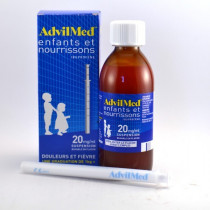Therapeutic indications
This medicine contains ibuprofen. It is indicated, in infants and children from 3 months to 12 years (approximately 30 kg), in: the treatment of fever and / or pain such as headache, flu-like symptoms, dental pain, muscle stiffness .
Dosage
The usual dosage is 20 to 30 mg / kg / day in 3 to 4 doses without exceeding 30 mg / kg / day. The drug is administered by means of the syringe for oral administration (graduated in kg) which delivers a dose of 7.5 mg / kg per dose. The dose to be administered for 1 dose is obtained by aspirating the suspension by pulling the plunger of the syringe for oral administration up to the graduation corresponding to the weight of the child. For each dose: · up to 25 kg: fill the syringe up to the graduation indicating the child's weight. Between 25 kg and 30 kg: fill the syringe a first time up to the 25 kg graduation then a second time until a total equal to the child's weight is reached (example for a child of 30 kg: fill a first the syringe once up to the 25 kg graduation and then a second time up to the 5 kg graduation); Over 30 kg: there are more suitable pharmaceutical forms.
Method of administration: Oral route. Shake the bottle well before use. Give water to drink after absorbing the solution. Frequency of administration: Systematic doses prevent oscillations of pain or fever. They should be spaced at least 6 hours. Duration of treatment: If the pain persists for more than 5 days or the fever for more than 3 days, or if they worsen or if a new disorder occurs, inform your doctor.
Composition
The active substance is ibuprofen. The other ingredients are: sucrose solution, glycerol, 70 percent sorbitol (crystallizable), polysorbate 80, sodium benzoate, anhydrous citric acid, sodium edetate, gum xanthan, strawberry flavor (contains vanillin), artificial flavor, acesulfame potassium, cochineal red A and purified water.
Pregnancy and breast feeding
ASK YOUR DOCTOR OR PHARMACIST FOR ADVICE BEFORE TAKING ANY MEDICINAL PRODUCT. This medication is intended for infants and children. However, in the event of use in exceptional circumstances by a woman likely to become pregnant, the following points must be remembered: Pregnancy: During the first trimester of pregnancy (12 weeks of amenorrhea, i.e. 12 weeks after the 1st day of pregnancy). your last period), your doctor may prescribe this medicine for you if necessary. From 2.5 to 5 months of pregnancy (12 to 24 weeks of amenorrhea), this medicine will only be used on the advice of your doctor and in short dose. Long-term use of this medication is strongly discouraged. Beyond 5 months of pregnancy (beyond 24 weeks of amenorrhea), you should under NO circumstances take this medication, because its effects on your child can have serious consequences, particularly on a cardiopulmonary and renal level, and that even with a single take. If you have taken this medicine when you were more than five months pregnant, please talk to your obstetrician-gynecologist so that you can be offered appropriate monitoring. Breast-feeding: This medicine passes into breast milk. As a precaution, it should be avoided during breastfeeding.




